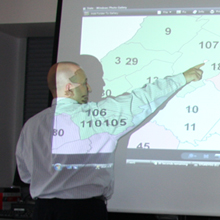Blank spots on the Virginia map
Virginia is dotted with resources that Nathan Alleman and his colleagues call "college access providers," entities that are as challenging to define as they are to identify.
Broadly defined, "college access providers"
are people or groups that help young Virginians to navigate the college
selection and admission processes. Such resources tend to be richer in
 areas
that have a generally higher college attendance rate.
areas
that have a generally higher college attendance rate.
"They're pieces of the sort of cultural-social capital that a lot of people just don't grow up with if they are not around people who go to college," he said.
Alleman, a visiting assistant professor at William & Mary's School of Education, leads a group charged with assembling a report showing where the scores of college access providers are across the state. More importantly, the study also was to identify the Commonwealth's underserved areas.
$1.1 million in funding
The study, commissioned by the State Council of Higher Education for Virginia (SCHEV), was funded through a $1.1 million federal College Access Challenge Grant.
Many resources can fit under the umbrella term "college access provider," Alleman said, from grass-roots "college nights" to sophisticated, multi-site initiatives such as Project Discovery or the 128 Commonwealth-sponsored career coaches around the state.
"They are anything from a state- or federally-sponsored program to something a local church or YMCA puts together," Alleman said. "That makes them very difficult to find and very disparate in their services and resources and in the type of activities that they aspire to."
Some providers, he said, focus more on the financial implications of going to college, while others get involved in SAT preparation or how to write an admission essay. "We wanted to get a better sense of what is really going on in the state," he said.
Working with Rachael Stimson of Western Carolina University and Neal Holly, a doctoral student in William & Mary's School of Education, Alleman started off with a survey of known access providers. "Snowballing" outward from the Virginia College Access Network list, the researchers identified nearly 450 individuals and organizations across Virginia as college access providers. (Their list did not include school counselors or teachers.) In questionnaires, they asked each about logistics, staff, funding, training and other nuts and bolts information.
"Then we did a qualitative component where we interviewed 25 of the providers-we spent about an hour with them-to talk about the challenges they face," Alleman said. "We wanted to hear about the victories, the things that keep them going and to get a fuller picture of what it means to be a college access provider."
Once all the data were in, Alleman and his colleagues realized they needed a way to present the data so that SCHEV, legislators, educators and other officials could not only see the geographic distribution of the providers, but also the nature and distribution of the services.
"Early on, mapping seemed like a great idea," Alleman said, "but we weren't sure how to go about it until someone referred us to Stu and the GIS program."
Alleman sat down with Stuart Hamilton at the Center for Geospatial Analysis to discuss his data and his desired result. For instance, it was easy to pinpoint the location of each provider, but not so simple to show the area that each provider served.
"Stu was very good in helping us to think through what our unit of analysis should be," he said. "It turned out to be the school district, even though there are some severe limitations there, but in terms of demographic information that we could link to our own data, it was the smallest unit that made sense."
Wrestling data into shape
The CGA helped the researchers take what Alleman described as "a fairly convoluted set of data" and convert it into a format accessible by, and helpful to, a number of lay users. Hamilton brought one of his GIS students, Ashley Ingram '11, into the project. She worked over the summer with the team, producing data-rich maps of Virginia
In November, Alleman presented his report, with some of the CGA maps, to SCHEV and other state and university officials. The GIS component is an ongoing aspect of the project, with Ingram's maps as a prime feature. The work is an integral part of a 280-page set of findings that have been sent to every school superintendent in Virginia, as well as to every state legislator.
"Those will also end up on the SCHEV web site," Alleman said. "They are developing an interactive map of the state where you will be able to click on an area and see all the providers based on our data. That is going to be a nice resource."
By Joseph McClain